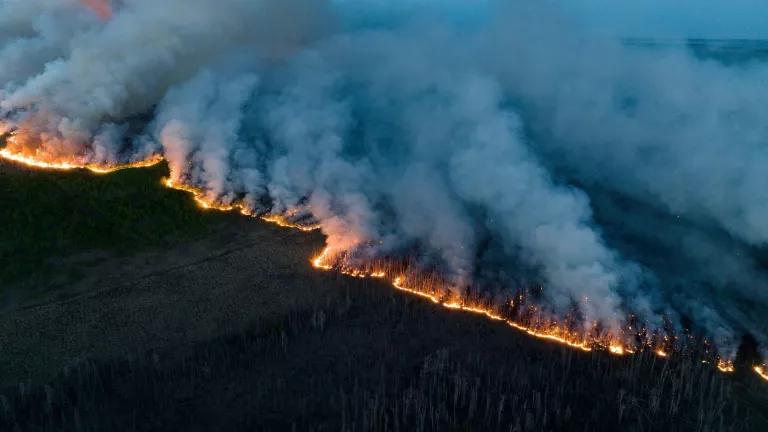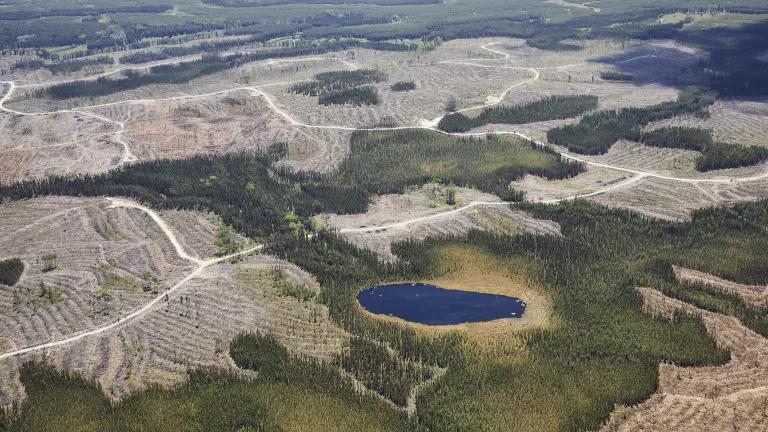Carbon Neutral or High Emitter? Canada and the Forest Carbon Loophole
Forestry can play a role in solving the climate crisis, but only if we start by getting the numbers right.

Natural or anthropogenic? Canada’s GHG reporting approach claims GHG emissions from wildfires are natural, but GHG removals from forests at the age of "commercial maturity", despite being primarily natural disturbance origin, are anthropogenic.
shaunl
This blog was co-authored with Dr. Jay Malcolm, Professor Emeritus, Forestry at Daniels, University of Toronto.
Our new study published in Frontiers in Forests and Global Change and profiled by CBC shows how Canada’s official report on forest carbon emissions are mischaracterizing forestry sector impacts. Other research suggested that, globally, the problem of undercounted forestry emissions could be explained by conceptual differences in what countries count as part of the “anthropogenic” (or human-caused) forest carbon flux and the way countries report on their forest harvesting sectors. Our research supports this is the case in Canada and that, more accurately depicted, forestry’s emissions have averaged 91 Mt between 2005 and 2021, rivaling those of other high-emitting sectors.
According to Canada’s greenhouse gas inventory reports, energy, transportation, and agriculture are the country's biggest emitters. The inventory reports depict forestry as a slight carbon sink, meaning it is reported as responsible for capturing more carbon than it emits. However, a closer look shows that forestry is not carbon neutral as the reporting would suggest – rather the opposite. Forestry appears to be carbon neutral in the national inventory due to conceptually problematic and inconsistent reporting practices.
Using methods developed by our colleague, Dr. Matthew Bramley, our study looked at the data in Canada’s published National Inventory Report and Common Reporting Format tables, isolating emissions and removals directly associated with forestry from those associated with forests more broadly. At an average of 91 Mt annually between 2005 and 2021 (annual mean = 90.8 Mt CO2e), forestry emissions are actually much closer to those of the highest-emitting sectors in Canada (e.g., in 2021, agriculture emitted 69 Mt, electricity emitted 52 Mt, and oil sands production emitted 85 Mt).
The discrepancy between Canada’s figure and our study results stems from loopholes in disentangling the natural and anthropogenic (human-caused) processes that determine forest-related fluxes. Only anthropogenic fluxes are meant to be reported as part of the sector’s actual emissions.
Natural removals and emissions are those that nature causes, whether humans are involved or not. On the other hand, human-caused removals and emissions are those that are under our control. Forestry-related factors that affect CO2 emissions and removals include tree harvesting, post-harvest forest regeneration and growth, and carbon storage in long-lived harvested wood products.
As a pragmatic solution for determining what should be reported as anthropogenic fluxes, the IPCC developed the “managed land proxy”. This examines all GHG fluxes occurring on land identified by the country as “managed land” and separates GHG emissions and removals from the "managed land" as “natural” or “anthropogenic” (see map below). But therein lies the rub.

Approximate distribution of managed forest (dark green) and unmanaged forest (light green) in Canada. Managed forest and unmanaged forest in Canada cover approximately 232 million hectares and 115 million hectares, respectively.
Natural Resources Canada
The significant gap between what Canada reports and our findings results from an imbalance in what emissions and removals Canada does—and does not—count as anthropogenic and therefore attributes to the forestry sector. Canada’s GHG reporting approach claims GHG emissions from wildfires are natural, but GHG removals from forests at the age of commercial maturity (at approximately 76 years on average), despite being primarily natural disturbance origin, are anthropogenic. The “credit” the forestry sector gets from these post-wildfire, older forests give the impression that forestry as currently practiced is not an emitter, which is wrong. It is like a dieter crediting themself for the caloric burn from a treadmill they are not on.

Components of forest carbon flows in Canada's GHG inventory averaged from 2005-2021.
Erika Rathje
This accounting has a certain, albeit questionable, logic to it. Many of those forests are covered by forest management plans, so they could be harvested in the future. However, this amounts to giving the forestry sector credit for the forests they haven’t logged (yet) and may never log. The fact remains that when forests are logged, even after accounting for post-cutting forest growth and carbon stored in harvest wood products, there is a net emission of large amounts of carbon into the atmosphere. There is also much more research needed to better understand how forestry practices, including fire suppression and road access, may be exacerbating wildfire vulnerability.
The government’s approach, which is by no means mandated by IPCC guidelines, is biased and needs to be revisited. It gives a distorted impression that current forestry practices are largely irrelevant to global warming or are even a climate solution. Not acknowledging the carbon emissions from forestry may lead to climate mitigation policies that are ineffectual or detrimental to reducing net carbon in the global atmosphere. Transparently and accurately reporting GHG emissions from the forestry sector is necessary to inform effective forestry-related policies and natural climate solutions.
With the increasing frequency and intensity of extreme weather events, rising temperatures, and the loss of critical ecosystems, it is imperative for all countries to reduce their GHG emissions across all sectors. We have at our disposal methods to reduce forestry emissions and make sure our forests actually help, to the best extent possible, in our fight against climate change. In forests across Canada, there are suite of options, including setting aside more forest areas from logging, shifting to partial harvesting in certain areas, planning for longer rotations and producing fewer short-lived wood products. Forestry can play a role in solving the climate crisis, but only if we start by getting the numbers right.



